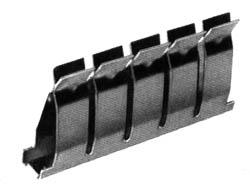Bread Board
A bread board is also known as a project board, It has got itself a place in every electronics hobbyist because of its "User Friendly" Nature, a bread board needs no soldering and already it is connected internally, lets see about it in detail.
This is how a bread board looks
A bread board is available in many shapes and sizes and has a facility to connect many boards as you like.
Connections in a Bread Board
NOTE: In some bread boards the top and bottom are not fully linked only 5 pins are linked.
Working
The heart of the solder-less breadboard is a small metal clip that looks like this:
The clip is made of nickel silver material which is reasonably conductive, reasonably springy, and reasonably corrosion resistant. Because each of the pairs of fingers is independent we can insert the end of a wire between any pair without reducing the tension in any of the other fingers. Hence each pair can hold a wire with maximum tension.
Using a Bread Board
Example Connection
This shows how a 380 ohm resistor and an LED are setup on a breadboard. When a 9 volt battery is attached the LED lights. Try replacing the resistor with a higher value such as a 680 ohm resistor. The resistance will be greater and the LED should shine less bright.
June 26, 2009
BREAD BOARD
Electronics is the study and use of electrical that operate by controlling the flow of electrons or other electrically charged particles in devices such as thermionic valves. and semiconductors. The pure study of such devices is considered as a branch of physics, while the design and construction electronic circuits to solve practical problems is called electronic engineering.
Popular article
-
In real this is how an TRANSFORMER looks like.. the transformer is a device that transfers electrical energy from one end of the coil to th...
-
In real this is how an LDR looks like.. A Light Dependent Resistor (aka LDR, photoconductor, or photocell) is a device which has a resist...
-
I n real this how a inductor looks like The circuit symbol of inductor is Functions of inductor the inductor (or) a reactor is a passive ele...
-
NPN transistors Code Structure Case style I C max. V CE max. h FE min. P tot max. Category (typical use) Possible substitutes BC107 NPN TO18...



0 comments:
Post a Comment